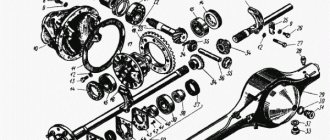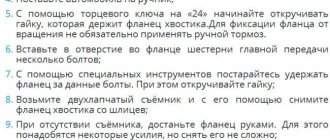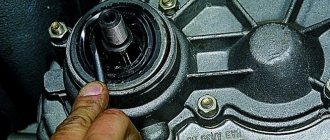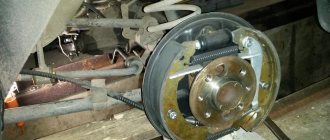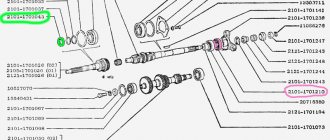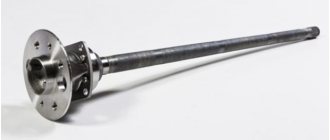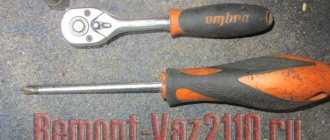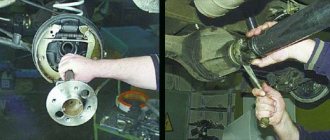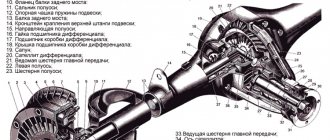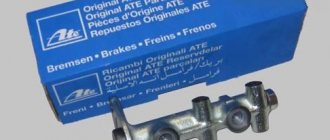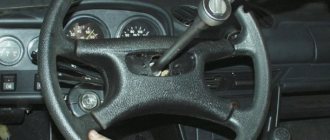Driving at high speeds with broken universal joint crosspieces does not go without consequences. The rear axle gearbox on the classic and Niva is designed in such a way that when the car moves forward, the shank seems to be unscrewed from the engagement of the main pair. The drive gear of the main pair (also known as the shank) rotates on two bearings: front and rear. The distance between them is elastically fixed by the pretension created by the spacer sleeve when the shank nut is tightened. The vibration of the cardan, transmitted to the rear axle gearbox, gradually unscrews the shank nut. Radial play appears in the shank - especially on the front bearing, because When moving forward, the shank is unscrewed from the joint of the main pair and the front bearing is freed for play. Radial play wobbles the unfixed spacer sleeve and oil flinger washer, gnawing out metal fragments that fall into the tapered bearing. After the fragments cut patterns on the rollers and bearing race, noise begins, which continues even after tightening the shank nut or replacing the spacer. In theory, in such cases, repair of the rear axle gearbox is required. Repair with complete disassembly, troubleshooting and assembly. The last stage is not performed by anyone in a city of millions at a reasonable price. Everyone just replaces the gearbox with a new one and moves on.
Replacing the front shank bearing.
I decided to go a different route. Replace the front tapered shank bearing without disassembling the gearbox. I calculated the distance between the shank and the front bearing race, which was exactly 13 mm. It is necessary to select a puller into this distance, the clamping tab of which can squeeze through. We searched for a long time at the service station, but found a puller with a suitable jaw width size - 13 mm. Only the puller was external, but we managed to twist the legs for internal removal. We started working with this tool.
The flanges were uncoupled. We tightened the nut, took out the bearing, bushing and washer.
Now all that’s left to do is pull out the outer race of the front shank bearing.
For a long time they tried to squeeze in 2 puller legs. Somehow I managed to do it right, right in the butt.
Next, the puller mechanics calmly pulled out the outer race.
Using a soft metal cage and a hammer, a new outer bearing race was pressed into place.
Front bearing wear.
I washed and wiped the removed bearing. I examined it carefully. The bearing was exactly the same as the one I purchased for replacement.
As expected, the impact of the chips did not go unnoticed.
Rear axle gearbox repair - main faults
- Rear axle gearbox repair - main faults
- 1. Why does the rear axle gearbox fail?
- 2. Repair of the rear axle gearbox - we change the part ourselves
- 3. How is the rear axle gearbox adjusted?
The rear axle is a unit of a vehicle (both wheeled and tracked), which connects the rear wheels along one axis. The wheeled (in our case) rear axle serves as a support for the rear of the car. By means of a suspension, the rear axle is attached to the frame of the car. Sometimes it happens that the rear axle is attached to the body supporting the frame.
The rear axle gearbox consists of several units. The main components are: main gear and differential. The main gear is the mechanism by which the gear ratio of the vehicle transmission is increased. The definition of this device, what it affects and how the given gearbox is serviced are the main issues that will be discussed below.
Why does the rear axle gearbox fail?
To answer all the above questions in detail, you need to familiarize yourself with the design of the gearbox itself. This unit consists of the two above-mentioned parts. The main gears are divided into single and double, which have one and two gear pairs in order to transmit engine torque to the wheels of the car.
Double gears (main gears) are of two types. Central double gears have a simple design, a large gear ratio and, at the same time, a significantly greater load on the elements of the entire system. Staggered double gears are more complex in design, but are nonetheless more compact and efficient, allowing the vehicle to have greater ground clearance.
Single main gears are:
1. Conical. The gears are located perpendicular to each other. This is why the entire structure takes up a relatively large amount of space. Nevertheless, the design is justified by its high efficiency.
2. Cylindrical. In this type, the gears are located in the same plane. This is what provides the potential for development towards maximum efficiency. The gear ratio in this type ranges from 3.5 to 4.2.
3. Worm-type. This type is less noisy and even more compact. However, the efficiency is quite low, and the manufacture of this type of main gear itself is quite difficult.
4. Hypoid. This type of single final drive is quite lightweight and, in comparison with its counterparts, even smaller in size. It also transmits engine force to the bridge itself much more reliably. However, of all the above types of gears, it has the most average efficiency.
A differential is a mechanism that is responsible for distributing torque between the drive axles and the drive wheels. The differential is an assistant when the car slides and slips. This is possible using different wheel speeds.
If the shaft flies from its intended place, it can easily destroy the entire gearbox housing. In addition, a frequent cause of breakdown can be simple neglect of oil, which was not poured into the rear axle gearbox on time. It would be more correct to say that the problem will be untimely oil renewal or its complete absence. It is important to know that the transmission oil should be changed at least every 35 thousand km of the vehicle.
Differential device
The planetary gear is mounted on the differential housing. The differential consists of two axle gears, two satellites and a pin. The main, most common differential malfunctions are wear of the pinion pin (play) and wear of the splines on the axle gears.
On a car, the play of the pin of the satellites can be determined by turning the driveshaft by a quarter or more; if there is no play, then the shaft practically remains in place when you try to turn it in one direction or another.
It's also worth noting that there is never any noise coming from the differential. When moving forward (in a straight line), the differential rotates as one unit and it turns out that there is simply nothing to make noise there.
The cause of noise from the rear axle gearbox when gas is added and the noise disappears after releasing gas is (almost 99.9%) wear of the teeth of the main pair. This is clearly visible on the removed gearbox. The forward side of the teeth has significant wear, while the reverse side shows little wear.
If, after disassembling and troubleshooting the parts of the main pair, wear of the teeth is detected, then no repair will help and it will simply be a waste of time and money. Only the main pair needs to be replaced.
Home-couple
The gears of the main pair are selected at the factory based on contact patch, noise and other parameters and are marked. For example, on the planetary gears it is stamped - VAZ 2103 (model), 10 41 (gear ratio), 4091 (pair number). The main pair number 4091 is also marked on the bevel gear.
After marking these parts, they became the “main pair” and are not installed one without the other, that is, “family”. “- 6” is also marked on the “tip”; this is an amendment for assembling the main pair in the gearbox. When troubleshooting a differential, its bearings are also checked for wear and, if necessary, replaced. Bearing wear is often caused by unprofessional replacement of the gearbox seal.
For example, after replacing the oil seal, tighten the shank nut without observing the tightening torque (pull as much as possible) and the force is transferred not to the spacer sleeve, but to the differential bearings.
As a result, after a short run after replacing the shank oil seal, noise from the gearbox appears. Only in this case, the “hum” noise in the gearbox is constant and unlike the noise from worn teeth of the main gear. In this case, the hum is constant, regardless of whether gas is added or released.
Rear axle gearbox assembly video
During assembly, the gearbox is adjusted according to 4 parameters:
1. Selection of the adjusting ring
Parameters from 2.6 to 3.5. The ring serves to adjust the depth of engagement of the teeth of the “tip” and “planetary gear”, which is strictly specified. This is where the “correction -6” is needed for this main pair, which was mentioned above. Of course, this amendment will be individual for each main couple.
In this video, the main pair will be adjusted using a special device. It is clear that the vast majority of motorists do not have such a device and this is just a clear example of adjusting the engagement depth parameter. An option will also be given for adjustment without a “device”.
A “device” with a micrometer is also installed on the device, simulating the gear of the main pair. The indicator shows zero. Then the indicator leg is transferred to the bearing bed and in this case the indicator shows a value of 3.25, which is not good, since it should be within the range of 3.0. On the second landing plane it turned out to be 3.45. The arithmetic mean is 3.3. To adjust, we will use the correction at the “tip” - “-6”. In this case (– 3.3) + (-6) = 3.36. The thickness of the adjusting washer required is 3.36 mm. Using a micrometer, select the washer of the required thickness.
Note. When the shank bearing wears out, it begins to rotate on the “tip” body. As a result, the bearing end, adjusting washer and shank gear bodies wear out. It turns out that when replacing the shank oil seal, even with the correct tightening torque, the adjustment of the depth of engagement of the teeth of the gears of the main pair is lost and the “howl” of the pair is ensured, as is its early failure.
2. Adjusting the preload of the shank bearings
The shank bearing sits on the “tip” and a NEW spacer sleeve MUST be installed. The video clearly shows that the new bushing is smooth without any deformation, while the previously installed one is deformed. What happens is this: When the shank nut is tightened to the prescribed torque (from 12 to 26 kgf), the bushing takes on the tightening force and, when deformed, works like a spring, creating tension. The tightening force for the VAZ 2107 gearbox nut is significant and the shank must be secured against turning.
In the video we see what kind of “device” the master uses. It is necessary to tighten the shank nut until there is no play. When the nut is tightened correctly, the shank should rotate with a resistance force of 0.3-0.4 kg, therefore, the bearing preload is correct. This assembly rule applies to old (used) bearings.
The differential with bearings is installed and secured with covers (tightening torque is about 8 kgf) and the adjusting nuts of the differential bearings are tightened.
3 and 4. Simultaneous adjustment of the thermal clearance of the main pair and the preload of the differential bearings
For these purposes, another “device” with two indicators is needed. Using the adjusting nuts in the video and everything is shown well, we move the planetary gear towards the teeth of the “cone” to achieve the required clearance. Factory clearance adjustment data is from 0.08 to 0.12 mm. However, such a gap is provided for the new main pair (“tips” and “planets”). The gap is checked in 4 planes by turning the gear. The gap for the working main pair after adjustment is 0.13-0.14 mm.
After making the adjustment, the adjusting nuts are locked with special plates for this purpose, with one or two “antennae”. This completes the assembly and adjustment.
Video of adjusting the engagement depth of the main pair
Adjusting the rear axle gearbox with your own hands without using special devices (the VAZ 2107 gearbox is the same).
In this case, it is necessary to select the thickness of the adjusting washer.
So: Instead of the device, we install the “original” shank and tighten the nut until it stops lightly, leaving a gap. The differential with planetary gear assembly, bearing caps are installed and their mounting bolts are tightened.
When replacing the shank oil seal, a number of incorrect actions are allowed, which ultimately lead to premature failure of the gearbox. Before releasing the shank nut, according to the technology for performing the work of replacing the oil seal, it is necessary to remove the axle shafts (which is almost never done, since the amount of work will increase many times). Although according to the price list, the removal of the axle shafts will most likely be included in the list and a fee will be charged for this, since this is required by the plant’s technology for replacing the oil seal. This is a necessary condition, since the axle shaft will create resistance when tightened and correct adjustment will simply be impossible to achieve.
Before releasing the shank nut, it must be secured against turning and the tightening force of the nut must be checked with a torque wrench, around 12 kgf. Before installing the oil seal, if its outer surface is not rubberized, then you need to use a sealant to guarantee it. Thus, a mark of 0.15 mm on the gearbox stocking will be sufficient to pass oil through the outer surface of the oil seal.
The adjusting nuts are installed, and the gap on the main pair is pre-selected (the final working gap is 0.08 to 0.12 mm). Then paint is applied to the teeth of the planetary gear from an aerosol can and, using a shank, it is necessary to make several movements in different directions in order to fix the contact spots in the paint.
Now, having turned the planet gear back, you can clearly see the contact patch on its teeth with the teeth of the pin. The contact patch (in this case) shows that the adjusting washer on the shank is thicker than the required thickness. We slightly tighten the shank nut, thereby moving its bearing, which makes it possible to move the gear teeth towards each other, that is, as if “reducing” the thickness of the adjusting washer. Using the differential bearing adjusting nuts, we set the approximate gap (reducing it slightly).
Then we again apply paint to the teeth of the planetary gear and again begin to rotate the shank (or gear) in different directions to print the contact patch between the teeth. It can be seen that the contact patch has risen a little, but still not enough and it is necessary to tighten the shank nut a little again. Similar actions with paint and turning the gear must be carried out until the contact patch is located exactly in the middle of the teeth, and the sound of the turning teeth becomes quieter.
After correct (final) adjustment, the sound will be almost inaudible.
Remember to tighten the differential bearing adjusting nuts every time you tighten the shank nut. As a result, the contact patch was located exactly over the entire surface of the teeth. It should be noted that this is the condition for the location of the contact patch for old (working) pairs. For new main pairs, the contact patch, as mentioned above, should be located in the center of the teeth.
Further. The planetary gear mounting covers are released and the differential is removed. The shank nut is unscrewed and removed. Since the shank was installed only with a bearing without an adjusting washer, there was a gap between the bearing and the shank gear where the washer would fit. This gap is measured with a set of feeler gauges, thereby calculating the required thickness of the adjusting washer.
It turns out, as in the case of using instruments and accessories, the size for the required adjusting washer was also 3.36 mm. The shank bearing is removed, an adjusting washer (3.36mm) is installed, the bearing is put in place and the gearbox is assembled. The shank is installed, the shank nut is tightened, min. 12 kgf. The differential with planetary gear is installed, the covers and bolts are tightened, but not completely.
By the way, the lids should not be mixed up. The adjusting nuts of the differential bearings are installed and the gap on the main pair is pre-set. Then the differential cover bolts are finally tightened. The gap in the main pair is finally adjusted and the adjusting nuts are secured.
Repair of the rear axle gearbox - we change the part ourselves
A malfunction of the rear axle gearbox is very easy to notice. The problem is identified during sudden braking, turning, or sudden acceleration of the vehicle. This type of problem is characterized by the presence of strong noise in the area where the rear axle is located.
Repairing the rear axle gearbox itself is a fairly simple process, even for doing it yourself. An initially necessary aspect will be to drain the transmission oil directly from the rear axle gearbox. The propeller shaft must be disconnected while the oil itself drains from the housing. After this, you need to dismantle the axle shafts. To do this, it is necessary to remove the brake drums and rear wheels.
After this procedure, you need to unscrew the bolts securing the bridge with the gearbox. If a new gearbox is installed, you need to use sealant and a cardboard gasket. After all of the above, you need to pour oil directly into the gearbox. The gearbox flange itself must be firmly attached to its place along with the bearings.
The device and design of the rear axle gearbox itself is not so complicated. In addition, the hypoid type is found on almost all rear-wheel drive cars. There is one particular difficulty, which is that there may be a problem with rust when removing the brake drums, and the metal itself can be pressed very hard in some places. However, some sheer human power and some tools will easily fix the above problem.
If a car enthusiast decides to independently purchase a new rear axle gearbox, then during the purchase itself he should pay attention to the fact that the price that sellers ask for the same models of gearboxes can be almost polar. The entire difference between these numbers will be just two letters OP, which means general verification.
In turn, this means that when checking the factory, a defect was detected in the device. In this case, the entire mechanism is sent for refurbishment, and is now sold at a reduced price. That is why you should only contact reliable official suppliers of parts for your car.
Checking the oil in the gearbox
For the rear axle gearbox of the “seven”, semi-synthetics with viscosity parameters 75W-90 are suitable, for example:
- CASTROL Syntrans Transaxle 75W-90 API GL-4;
- "Lukoil 80W90 GL-5" and others.
1.35 liters of oil is poured through a special filler hole on the gearbox housing. If you need to drain the used oil, there is a drain hole in the bottom of the gearbox for this purpose. Before draining the old oil, it is recommended to warm up the car, place it on a flat surface and jack up the right side of the car . If there are metal shavings in the waste, you should rinse the gearbox container with a special liquid or spindle oil.
For the rear axle of the VAZ 2107, CASTROL Syntrans Transaxle 75W-90 API GL-4 oil is suitable
It is convenient to fill in new oil using a special syringe, which can be purchased at a car store. Both plugs (drain and filler) should be securely tightened, and then check the condition of the breather, which should move freely. If the breather jams, the contact of the container with the atmosphere will be disrupted, which will lead to an increase in internal pressure, damage to the seals and oil leakage. The oil level in the rear axle gearbox is considered normal when the liquid reaches the lower edge of the filler hole.
Video: changing the oil in the gearbox yourself
Repairing and adjusting the most critical components of the rear axle, as a rule, requires some practice, so it is best to perform it under the guidance of an experienced specialist. If you hear extraneous sounds from the rear axle while driving, you should immediately determine the cause of their occurrence. By ignoring such noises, you can “start” a breakdown and subsequently face complex and expensive repairs. Following simple rules for operating and maintaining the rear axle will extend the life of the vehicle for many years.
How is the rear axle gearbox adjusted?
Adjustment of the rear axle gearbox should be carried out in certain cases when the gearbox itself has a characteristic hum, which can be heard already at speeds of 30 km per hour. The reason for this may arise due to the huge and constant loads of the vehicle. Also, problems can occur due to constant driving with trailers or normal damage to the car’s mechanics. That is why the next scenario should be a visual inspection of the entire unit.
First you need to remove all the elements of the rear axle gearbox: flanges and seals, satellites along with axles, bearings. These elements must be removed, and if one or more of them wears out, a complete replacement with a new part is necessary. How all the parts should initially look can be determined in the vehicle’s operating manual. If we talk about domestically produced cars, then replacing all the parts of this device will be inexpensive.
After all the parts have been checked individually, everything has been replaced and is considered to be in good working order, you need to put the gearbox back together. The drive gear must go first; it is accompanied by an adjustment washer, a flange and a spacer sleeve with bearings. After this, you need to tighten the nut, but with a certain force. You can use a special wrench with a built-in dynamometer for this. If you don’t have this at hand, you will have to use a measuring lever with a steelyard all the time.
Thus, every millimeter of lever travel will need to be accompanied by a constant measurement of pressure using gasoline on it. This is a rather troublesome process, so caution and accuracy are paramount here. The nut itself should be tightened to one Newton. The flange will remain motionless. It needs to be secured with a special key with spacers, which ideally fits the grooves of this flange.
After all the work done, you need to put the driven gear in its original location, that is, in the differential housing itself, after which you need to tighten all the necessary bolts. Right now the direct and long-awaited adjustment of the backlash will begin. After all the parts have been installed and all the nuts have been tightened to the minimum stop, you need to turn the driven gear.
After this, you need to see if it has a slight backlash. In order to determine this, you need to rock it from one side to the other. There should be some play, but it should be small. Thus, this backlash is a kind of reserve that is required to heat the gearbox during direct movement in order to avoid bursting of parts.
After all the above procedures, you need to check the distance between those bolts that should hold the nuts, which, in turn, were recently tightened. To do this, you need to use a caliper, as accurate numbers are required. After the distance has been measured, it is necessary to tighten the nuts on the other side of the plane. It is advisable to do this by the same amount.
Afterwards, you need to measure the distance between the bolts. It should have changed by one and a half to two millimeters. If everything turns out this way, then you need to check the gear for play. It should be noted that it should remain the same as we recently configured it. That's it, the adjustment is complete.
Subscribe to our feeds on Facebook, Vkontakte and Instagram: all the most interesting automotive events in one place.
Rear axle gearbox repair
The rear axle gearbox is one of the most important elements of the car, which is directly involved in its movement . Of course, when comparing domestic VAZ, GAZ and other cars with imported ones, you can find a lot of differences, but the general operating principle is the same. There is a main gear, that part of the mechanism to which the cardan is attached and called the shank, and a differential. On VAZ cars it consists of just a pair of gears that are connected to axle shafts, but the situation with foreign cars is completely different. For example, on Opel Omega cars only transmission mechanisms are installed, and CV joints are attached to them. Thus, it turns out that there is no bridge as such. In this regard, its design becomes much more complicated. But this provides advantages in driving comfort and reduced noise in the chassis.
This is interesting: Selection of Bilstein shock absorbers for a car
Rear axle gearbox
Causes and signs of failure
As a rule, the oil seal in the VAZ 2107 gearbox is replaced because it begins to leak. Over years of use, the sealing lip may dry out or tear. A leak can also be caused by improper installation of the oil seal.
You can definitely identify a malfunction by the following signs:
- After parking for a long time, an oil stain remained on the road.
- Droplets of oil appeared on the bridge body.
- Near the gearbox shank, characteristic traces of leaking oil are visible.
Main reasons for failure
The rear axle gearbox consists of a large number of spare parts, the failure of any of which can lead to its failure:
- One of the most common reasons for this is constant increased loads, for example, towing trailers and other heavy vehicles. This constantly creates a large load on all elements.
- One of the equally common problems that appears after 5–6 years of vehicle operation is the appearance of play in the crosspieces. This occurs due to constant impacts and shocks arising from unregulated ignition and increased engine detonation. Therefore, during repairs, attention is paid to all elements of the chassis. And it doesn’t end with replacing the transmission mechanism.
- And it should be remembered that if the rear axle gearbox is empty and there is no oil in it, this can lead to it jamming, the teeth on the gears may break, or steel parts may burst due to overheating. Therefore, to avoid such troubles, always check the presence of lubricant.
- There is another type of malfunction that can only appear after many years of operation. In this case, the whole point is in the production of bearings located in the so-called stockings, part of the bridge housing in which the shafts rotate. Which, as a result, can lead to bending of the shafts, then destruction of the gears. And this will thereby lead to the rear axle gearbox becoming unsuitable for repair.
Rear axle gear parts
The rear axle gearbox installed on VAZ vehicles has two main elements:
The main gear can be of two types:
In turn, double transmission can be of two varieties:
The central one is a rather simple design with a large gear ratio, but at the same time high loads are created on all transmission elements. The spaced one is a more complex unit, but the load on all components of the device is evenly distributed, it is more compact and the vehicle’s ground clearance can be increased. Thanks to these advantages, their service life increases several times. But due to the reduced gear ratio, not all car enthusiasts prefer them, so they have to choose based on their priorities. If the car is equipped for fast driving, then it is better to use a rear gearbox with the first gear option. If the car will work as a tractor, then the second option is better. In turn, single gear is divided into the following types:
- Cylindrical, the gears are located in the same plane, which ensures a maximum transmission ratio that ranges from 3.5 to 4.2.
- Conical, perpendicular arrangement of gears relative to each other due to which the housing is enlarged, but at the same time a very high efficiency is achieved.
- Hypoid, a lightweight option with a convenient arrangement of components, has the lowest efficiency of all the above mentioned ones.
- Worm drives are the most complex mechanical units, which are difficult to manufacture and rent, and at the same time have the lowest efficiency.
So, having dealt with the main gear, let's move on to the second part that makes up the rear gearbox - the differential. It is a more complex mechanism that transmits and distributes torque between the drive wheels and drives the second axle via a cardan.
Symptoms of a problem
As soon as the driver notices any changes in the operation of the rear axle (for example, extraneous sounds appear that were not there before), he must respond to these changes as quickly as possible so as not to aggravate the possible malfunction. The most typical sign of such problems may be increased noise levels:
- coming from the rear wheels;
- during operation of the rear axle;
- when accelerating the car;
- when braking with the engine;
- during engine acceleration and braking;
- while the vehicle is turning.
In addition, a knocking sound when the car starts moving and an oil leak may indicate a malfunction of the rear axle.
Oil leakage indicates a malfunction of the rear axle of the VAZ 2107
Grinding noise when moving
The causes of a grinding noise from the rear axle when the vehicle is moving can be:
- wear or destruction of axle or differential bearings;
- deformation of the beam or axle shafts;
- incorrect adjustment, damage or wear of gears or bearings of the gearbox and differential;
- wear of the spline connection with the semi-axial gears;
- incorrect adjustment of the gear teeth of the main gear;
- insufficient amount of oil.
The cardan spins, but the car does not move
If the driveshaft rotates while the vehicle is stationary, the cause may be a failed axle spline or wear on the teeth of the differential or final drive gears. In any case, if the cardan spins, but the car does not move, this indicates a fairly serious breakdown and, most likely, replacement of the axle shafts, bearings or gears will be required.
Oil leakage from the housing and from the shank side
The most likely causes of oil leakage from the rear axle housing:
- wear or damage to the drive gear seal;
- wear of the axle shaft seal, determined by oiling of the brake shields, drums and pads;
- loosening the bolts securing the rear axle gearbox housing;
- damage to sealing gaskets;
- axial play of the shank;
- breather jamming.
Wheels are stuck and won't rotate
If the rear wheels are jammed, but the drum and pads are in order, the cause of this malfunction may be failure of the bearings or the axle shaft itself. Most likely, in this case, the bearings have crumbled or the axle shaft has become deformed (for example, due to an impact) and the parts need to be replaced.
A little leaked oil from the axle through the axle seal + dust from the pads = good “glue”. Bottom line: remove the drum and look. If all the springs are in place and the block is not torn, then take sandpaper and clean the drum and shoes. Pre-wash them with carburetor cleaner or similar liquid. Sold in cylinders.
underwater snake
https://auto.mail.ru/forum/topic/klassika_zaklinilo_zadnee_koleso_odno/
DIY repair
Rear axle gearbox repair
Repairing the rear axle gearbox is not very complicated and does not require specialized knowledge, but before disassembling and reassembling it is better to familiarize yourself with the technical documentation. Before starting all work, it is necessary to raise the rear of the car so that the wheels are free and the gear is in neutral. Next, you need to unscrew the plug to drain the lubricant, and while it flows out, proceed to remove the cardan. When raised, you can freely scroll it in order to unscrew the 4 bolts that secure the shank. But before disconnecting, it is necessary to put a mark on the shank of the transmission mechanism and on the cardan, because it is screwed in only one of 4 positions.
Repairing leaks
If the shank is always wet from grease, then the gearbox seal most likely needs to be replaced. To do this, just disconnect the cardan. Next, you need to unscrew the drive gear nut and remove the flange from its shaft. Under it there is an oil seal, which can be removed using a thin but hard tool, slightly picking. Then use a clean rag to remove all the old grease and evenly press in the new oil seal and put on the flange. The hook must be clamped with the required force, which should be 1 Newton.
If the shank is dry, and the source of the leak is the junction of the transmission unit with the bridge, then it is necessary to replace the cardboard gasket; for this it is necessary and sufficient to unscrew the gearbox itself. Here a 12mm socket wrench will help you, with which you need to unscrew 8 bolts. After removing the mechanism, it is necessary to thoroughly clean the contacting surfaces of dirt and old gasket and carefully put on a new one, lubricated with sealant. The bolts are tightened thoroughly, but not to the point of stripping the threads. A new lubricant TAD-17, GL-5 or TM5-18 is poured.
Next, align the driveshaft shank with the flange at the mark and tighten it using new nuts, because they have plastic retaining rings that are disposable.
Adjustment of the rear axle gearbox consists only of the main gear hook, which is attached to the shank, so, as a rule, there is no problem with it. The only problem is the application of a force of 1 N and how to measure it.
The entire repair of the rear axle gearbox usually takes little time, because there is nothing complicated.
Installation of the drive gear of the VAZ and Lada Niva gearbox.
The second sign of a loose nut is the presence of axial play in the drive gear. Grasp the flange with both hands and move it back and forth (the car is on a stand, with stops under the wheels). The drive gear nut may be unscrewed a full turn or more (1 turn - axial movement - is equal to the thread pitch, i.e. 1.5 mm). Here we are no longer talking about preload and you are lucky that the gearbox is still working.
Replacing the rear axle gearbox seal on a VAZ 2101-VAZ 2107
Welcome! Rear axle gear oil seal - in general, oil seals serve for a long time, but if they are of poor quality, or if they are not installed correctly, or ultimately if the oil is poorly filled, then their life is immediately shortened, previously (and still) data things were called oil seals, but by the new name they are rubber cuffs, but rarely does anyone say this, and it’s not customary, thanks to this unit, engineers ensure oil containment in the steering mechanism, in the engine and in other places, the oil seal can also serve to contain diesel fuel and water and thanks to it, by the way, dust and dirt do not get into the mechanism they close.
Note! To replace the oil seal on a car, you don’t need much, the most important thing is: Stock up on all kinds of wrenches, also screwdrivers, and if you have torque wrenches, then it’s generally good (Thanks to these wrenches, the tightening torque of the bolts can be set correctly, just if you don’t tighten the bolts while driving they can get unscrewed, and re-tightening won’t lead to anything good) take them too, you’ll also need to stock up on a mounting blade and a torque gauge, but that’s if you don’t have a single torque wrench!
Summary:
Where is the rear axle gearbox seal located? You won’t see it that easily, firstly you will need to crawl under the car from below, you will see the driveshaft (Many people call the driveshaft, but this is not the correct name, since the driveshaft consists of shafts and in this case the term driveshaft, means any part of the cardan transmission) with the rear shaft it will be connected to the rear axle gearbox, namely to the rear flange of the gearbox (indicated by the blue arrow) it will be connected using four bolts (On the flange, see the photo below, the slots for the rear cardan mounting bolts are visible, for clarity, one of the slots is indicated by a green arrow) and the flange itself is secured by a healthy nut, which is indicated by a red arrow, so you will need to disconnect the rear driveshaft (As you read the article, we will explain to you how to do this) and hang it, then the same Unscrew the healthy nut and, using a hammer or a special puller, remove the rear gearbox flange, which is indicated by the red arrow. After removal, you will see the picture shown in the small photo, namely the same oil seal that you are going to replace, it is also indicated by the red arrow.
When do you need to change the rear axle gear oil seal? You yourself will most likely only understand this when all the oil from the gearbox leaks out through this oil seal, in general, when this oil seal wears out through it, the oil that is in the gearbox begins to leak out, you can only notice leaks if you look under the car more often or in the case when all the oil is leaks from the gearbox, then there will be a strong hum from behind and vibrations may still occur, usually not very noticeable, so if you have already begun to hear a stronger sound from the rear of the car, then stop somewhere and touch the gearbox with your hand (in winter, not very convenient, since the roads are dirty and the gearbox immediately gets dirty and the oil is not so easy to feel) if you find oil on it, it means it is leaking somewhere, if in the place where the oil seal is installed (see photo above), then the oil seal must be replaced, Oil may also leak from the gearbox if the drain plug is not tightened properly, so check its condition too.
Note! If you find just fogging on the gearbox (smudges may also appear at first), then you don’t need to climb into it, you only need to climb into it if you find drops of oil on the gearbox, this will already indicate 100% that there is oil leaking somewhere, besides this there is also a breather on the gearbox (it is indicated by an arrow in photo 1) thanks to it, all the excess pressure that is created in the gearbox comes out and if it is clogged, then the excess pressure will not come out of it, but will come out through the seals and other weak points. therefore, if you changed the rear axle gearbox seal and after a short time this seal started to leak again, then check the functionality of the breather, to do this, grab it with your hand (namely its cover) as shown in photo 2 and move the cover in different directions , everything should press and move without jamming, otherwise replace the breather with a new one (how to do this is shown in one of the videos at the very bottom), if the breather cap moves normally but oil still oozes through the oil seal, then remove the breather (It is turned out using a wrench by the thread which is indicated by the red arrow in the second photo) and clean it (You can clean it with any carburetor cleaning liquid, you can also rinse it thoroughly in gasoline and then blow it off with compressed air to remove all dust and dirt), after cleaning, install it in place by wrapping it in the gearbox and after a while (After 30 kilometers) climb under the car and check whether the oil is leaking through the gearbox seal; if it is leaking, change the breather or change the seal as it is faulty or incorrectly installed!
This is interesting: Comparative characteristics of 16 and 8 valve engines
Step-by-step replacement process
- We drive the car into the pit and unscrew the propeller shaft mounting bolts, having previously made a mark on the flank of the cardan and gearbox. After unscrewing the cardan, we tie it with a wire so that it does not interfere.
Using a special wrench, we secure the flange from turning and, using a wrench or a twenty-seven socket, unscrew the nut. The key for fixing the flange is shown in the photo below. You can also screw two universal joint mounting bolts into the flange and insert a powerful screwdriver between the bolts.
Unscrew the plug and drain the oil from the rear axle.
We remove the flange from the slots and take out the thin ring behind it using two screwdrivers.
- Using two screwdrivers, remove the inner race of the bearing.
- We take out the spacer sleeve. This bushing is needed to create the correct tension in the bearings. Please note that the belt of the bushing you removed is barrel-shaped, but on the new bushing it is straight. At the moment of tightening, the belt is wrinkled and the correct tension is achieved. The photo below shows a new bushing and one that was already working.
- We install a new bushing, with the narrow side facing the trunk. We also install the ring.
- We hammer the oil seal into place using a mandrel. The mandrel can be made from a piece of pipe of suitable diameter or from an old oil seal. As a last resort, the oil seal can be carefully seated with a hammer.
Lubricate the sealing edge with fresh oil and place the flange on the splines. Make sure that the sealing lip of the oil seal does not curl up.
How to replace the rear axle gearbox seal on a VAZ 2101-VAZ 2107?
Removal: 1) At the beginning of the operation, you will need to drain all the oil in the gearbox, because if it is not drained, then when you remove the oil seal, it will simply pour out through that place, if you do not know how to drain the oil, then in this case, read the article entitled : “Changing the oil in the rear axle gearbox on a VAZ.”
2) Now, in the place shown in the photo below, insert a screwdriver and unscrew the same four bolts securing the rear propeller shaft to the gearbox flange, and then disconnect the shaft and bring it by any means (you can use a rope to the muffler, but only look if the car If you have it warmed up, then the muffler will be very hot, so don’t get burned on it, and a weak rope may also not withstand the heat, by the way), we also wanted to explain to you that instead of a screwdriver you can use a mounting blade, all this is done because the driveshaft can be rotated with a screwdriver or Using a mounting blade, you seem to secure it from rotation and normally unscrew the bolts securing the rear propeller shaft to the gearbox flange.
3) Then you will need to determine the moment of resistance to turning the drive gear of the rear axle gearbox, this moment can be determined using a dynamometer or a torque wrench, the photo below shows two test cases, namely, to check the dynamometer you will need another strong rope, wrap it around the flange as shown in photo 1 (The first time, wind a little, just two turns and that’s enough) and after that, connect a dynamometer to the end of the rope and start winding the rope with it, when winding the flange should begin to slowly rotate, you write down this force that is needed to move it from place from the readings of the device and with this force, when you install everything in its place and watch that the flange rotates in the same way, if you do not have a dynamometer, then pick up a torque wrench whose measuring range will be approximately up to 147 N cm (15 kgf cm) and using it to tighten the flange fastening nut, find the force with which it is screwed and with the same force you will screw the same nut when reassembling all the parts.
Note! If you don’t have these devices, then you can pick up a marker and use it to make two marks (One on the flange itself, and the other on the nuts), as you can see in the photo below, the marks are all made and they are relative to each other, You can do this too, but just don’t draw anything on the edges of the nut; it’s better to make a mark (Indicated by a blue arrow), otherwise if you draw on the edges, when you unscrew it, you may tear off the thread a little and after that you won’t see any marks!
4) Next, take the wrench and socket head in your hands and with their help unscrew the central nut securing the gearbox flange, but just do not forget to lock the flange so that it does not rotate on its own when you unscrew the nut, and you can lock it using the special wrench that you need will make it yourself (it is made from a piece of tube and two bolts, shown in more detail in a small photo), after making the key, lock the flange with it as shown in the photo and completely unscrew the nut securing this flange and remove it after which.
Note! If you made marks, then count how many turns the nut makes relative to the mark on the flange, that is, you unscrew the nut; there is a mark on it and on the flange too, so if this mark passes through the mark on the flange 20 times and only after that the nut is removed, then in this case, when you put everything back together, tighten the nut in exactly the same way exactly 20 turns and at the end align its mark with the mark on the flange!
5) Next, remove the flange itself (indicated by the blue arrow), when the nut is removed, you can remove it with a special puller (indicated by the red arrow) which is sold in car dealerships, or from the reverse side, gently tap the flange with a hammer through a wooden spacer (a board for example) and so on remove the flange from the gearbox.
6) Now you will need to take a screwdriver or a wrench (a wrench is used in the photo below), and using the tools inside as shown in the photo, pry up the oil seal and remove it from the hole in which it is installed.
Note! When the oil seal is removed, wipe the place where it was installed from dirt with a hoe; for clarity, in the photo below this place has already been cleaned and where it needs to be cleaned is shown with arrows!
Installation: 1. Before installing a new oil seal, its working surface (indicated by the red arrow) that will go into the hole must be lubricated with Litol-24 grease.
2. After lubrication, install the new oil seal in its place and hammer it in through the mandrel (indicated by the red arrow). Firstly, the mandrel must be of a suitable diameter and you must hit it along the edges of the oil seal (the edge is indicated by the blue arrow) and you need to hit it until the oil seal enters to a depth of 1.7-2 mm from the end of the gearbox (the end is indicated by a green arrow), this distance can be very well checked with a vernier caliper or you can also try with a small ruler.
Note! For such a mandrel, you can use different things, for example, a faulty bearing can be taken of a suitable diameter or a piece of pipe can be found anywhere, etc.!
3. Now lubricate the working surface of the oil seal from the inside with clean oil and apply grease to the flange as shown in photo 2 so that, firstly, the flange is more easily pressed into the oil seal, and secondly, additional lubrication will not hurt.
4. And in conclusion, we note that install all the parts removed in their places in the reverse order, but just don’t forget about the tightening torque of the flange fastening nut, or if you drew marks, then strictly everything must be removed according to them, if you tighten this nut, then the gearbox bearing will be subject to greater force and therefore you will soon have to disassemble the gearbox to repair it; in addition to the bearing, the spacer sleeve will also be deformed; in general, retightening will not lead to anything good, so be careful.
Note! For more details on how to tighten the nut securing the gearbox flange, see the video below, all this is explained in detail and a couple more words are said about the spacer sleeve, namely where it is located, as well as about its deformation and a couple more good tips are there !
Additional video clip: For information on how to replace the gearbox drive gear oil seal, see the video below, in which everything is clearly and clearly explained.
Note! If you want to see information about the same breather that is wrapped in the gearbox, then watch the video below, in which everything is explained briefly but in detail!
Site about off-road vehicles, SUVs, off-road vehicles
The preload in the bearings of the drive gear of the VAZ and Lada Niva gearbox is created using a S24 M16x1.5 nut with a nylon insert. It is necessary to ensure accurate rotation of the drive gear, and therefore maintain the correct meshing of the gears.
Tightening the nut of the drive gear (shank) of the VAZ and Lada Niva gearbox, symptoms and troubleshooting, diagnostics of the condition of the gearbox.
The nut is tightened with a significant torque of 12-26 kgcm. With a wrench with a 300 mm arm, this corresponds to a force of 36-72 kgf; tightening this connection is not easy. It is this force, the nylon insert, the fine thread and the elastically deformable bearing spacer that prevent the nut from loosening itself. However, gradually the tightening of the nut begins to weaken, the elastic spacer sleeve is unloaded and the tension in the thread disappears.
A feature of the hypoid gears of the rear drive axles of VAZ cars is that when moving forward, the drive gear seems to be pushed out of gear, and during reverse and engine braking, it is retracted. The main gear of the front axle of the Lada Niva works in the opposite way - when moving forward, the drive gear is pulled into gear.
Any movement of the drive gear is undesirable. But it is especially bad if retraction into engagement occurs with weakened bearing tension. The transmission jams (pinches), the load on the bearings increases sharply.
Characteristics of gearboxes for VAZ cars.
The first signal that the drive gear nut has become loose is the hum of the rear axle's final drive when the engine brakes (the wheels rotate the engine). This hum can be heard both when shifting gears “up”, when the engine slows down slightly, and when shifting “down”, when it accelerates. When coasting there is usually no hum, since there is no load.
Only the drive gear rotates from the wheels (here it is already the driven gear), the driveshaft and the driven (secondary) shaft of the gearbox. It is advisable not to let things get to the point of buzzing, but in any situation when the propeller shaft is removed, check the tightness of the drive gear nut. This operation can be done by lifting only one wheel without a lift or ditch. But there will be fewer amenities, and you will spend more energy and nerves. Don't forget about stands and wedges (stops) for the wheels.
Checking the tightening of the drive gear nut of the VAZ and Lada Niva gearbox.
First of all, we clean the gearbox neck, drive gear flanges and cardan joint from dirt. To get to the nut (S24 M16x1.5), you need to disconnect the flanges and move the propeller shaft to the side. It is balanced separately from the drive gear with a flange and still mark the relative position of the flanges with paint or a punch.
The nuts (S13, M8) of flange bolts with special heads that are to be unscrewed require very careful attention. Do not use a spanner or socket here. A regular open-end wrench “13” (S13) must be new or, in any case, tightly cover the edges of the nut. You can make a “dense” S13 key from an S12 key.
The fact is that the nuts of the flange bolts can be tightened to a torque of up to 3.5 kgf (with a wrench arm of 150 mm - a force of 21 kgf). If we take into account that the coefficient of static friction is always greater than the coefficient of sliding friction, the force on the key will be considerable. At the slightest “slack” in the key, the hexagon of the nut will quickly be crushed (“licked”). When rounding the corners of the nut faces, as a rule, a hammer and chisel are used. If there is nothing to replace the nut after this, you have to machine its edges for an S12 hexagon.
We begin to unscrew the nut that is in a comfortable position (then we turn the driveshaft), not forgetting about the bolt. The fact is that the conical head of the bolt has a flat, while the bolt rests against a special milling of the flange and is kept from turning. There is no point in rotating the nut and rotating the bolt along with it, thereby crushing the edges. It is better to jam the bolt head with a screwdriver in a timely manner.
When all the nuts are unscrewed, the bolts are removed, and when removing the propeller shaft flange, oil is found between the flanges - this is the first sign that the shank nut has been unscrewed and hot oil has easily penetrated into the interflange space through the unclamped ends of the parts and the spline joint.
Installation of the drive gear of the VAZ and Lada Niva gearbox.
The second sign of a loose nut is the presence of axial play in the drive gear. Grasp the flange with both hands and move it back and forth (the car is on a stand, with stops under the wheels). The drive gear nut may be unscrewed a full turn or more (1 turn - axial movement - is equal to the thread pitch, i.e. 1.5 mm). Here we are no longer talking about preload and you are lucky that the gearbox is still working.
Tightening the drive gear nut of the VAZ and Lada Niva gearbox.
So, you got to the shank nut, but before you tighten it, it makes sense to unscrew it. This can often be done by hand without using a key. But you may need more than one key. You can unscrew the nut only by holding the drive gear flange. A special or universal wrench is used to hold the flange.
Universal wrench for flanges and hubs.
If tightening the nut is a “one-time event” and there is no special wrench, you can get by with two M8 bolts and a wrench (metal rod). The bolts are inserted into the flange holes, and the knob is placed between the bolts in front of the flange. If the knob is placed behind the flange, you may accidentally press on the dirt deflector, after which it will need to be secured to the flange.
After unscrewing the nut, it is necessary to remove oil from the threads of the nut and the gear shank, which will significantly increase the coefficient of friction and, consequently, the moment of resistance to unscrewing the nut. It is better to install a new nut, since the thread of the gear shank is imprinted in the nylon of the insert, which reduces the resistance to self-loosening of the nut.
The nut must be tightened, as noted above, with a torque of 12-26 kgcm; tightening is controlled by the moment of resistance to rotation of the drive gear - 4-6 kgcm. Since this moment cannot be measured “in its pure form” (the gearbox has not been removed), we measure it with the nut loosened and, adding 4-6 kgcm to the resulting value, we obtain a controlled moment of total resistance.
The easiest way to measure torque is with a spring scale (steelyard). So, if the moment of resistance is 4-6 kgf, and the hook of the scale is hooked onto the flange hole, then the force on the scale should be 1.1-1.7 kgf. Let us remember that the moment of resistance to rotation is measured, and not the starting moment, which is much higher. All these measurements may seem complicated, but they are necessary for reliable operation of the gearbox.
Diagnostics of the condition of the gearbox (bearings, gearing) of VAZ and Lada Niva cars.
Now let's look at cases where tightening the nut alone is not enough. We will also talk about diagnosing the condition of the gearbox (bearings, gearing).
1. Rotating the drive gear by the flange, we feel a uniform periodic increase and decrease in the moment of resistance - “roller busting”. This phenomenon is the stronger, the greater the preload, if both wheels are raised and, of course, in the case when the gearbox is removed and the differential box with the driven gear is removed from its housing.
“Roller busting” is a violation of the geometry of the raceways and bearing rollers, a sign that if the gearbox has not yet “hummed,” then this is about to happen. In the latter case, the matter may be aggravated by the appearance of waves on the gear teeth. Then the hum will turn into a howl - and the defect (waves on the teeth) cannot be eliminated.
Rear axle gear shank
The shank oil seal is one of the elements of the rear axle on VAZ-2107 vehicles. In general, it has a long service life, but incorrect installation, installation of low-quality parts or wear can lead to a leak in the area of the drive gear shank of the gearbox. The malfunction can be easily diagnosed if oil drops suddenly appear on the outer part of the gearbox housing.
If there are any, the shank oil seal needs to be replaced (see video below). If there are no drops, and the gear housing is covered with a thin oily film, then there is no need to install a new oil seal.
Please note that the replacement process requires certain qualifications from the performer. In case of gross errors, the gearbox may need to be disassembled and repaired, and this work can only be done in a workshop.
How to remove the rear axle oil seal
To replace the shank oil seal on a VAZ-2107, stock up on a torque wrench and a two-jaw puller.
The algorithm of actions is as follows:
- Drive the VAZ-2107 to a place convenient for performing work (this can be a hole or an overpass).
- Drain the lubricant from the rear axle.
- Separate the driveshaft from the drive gear flange.
- Pull the handbrake lever all the way up. This ensures that the machine is secured while the repair is being carried out.
Use a twenty-four socket wrench to remove the mounting nut holding the shank flange. The flange can be secured without applying the handbrake. To do this, insert the bolts into the holes in the drive gear flange. Then hold the flange to prevent twisting and use a tool (such as a pry bar) to tighten the flange retaining nut.
After that, do the following:
- Take a two-jaw puller and, with its help, press out the shank flange. Your task is to remove it from the splines of the drive gear. If you're lucky, you'll be able to tighten the part manually, without using a special tool.
- Remove the washer from the shank, as well as the flange with the dirt deflector.
- Pry up the oil seal using a screwdriver, then remove it from the gearbox housing.
Torque Tips and Common Mistakes
- Do not jerk the cylinder head bolts. Tightening should be done smoothly.
- When installing cylinder head bolts (especially old ones), carefully examine their condition - there should be no damage to the threads. Exactly the same as inside the installation site.
- If necessary, the part must be cleaned of contamination.
- It is better to lubricate the threads with oil, but pouring them into the mounting holes is not recommended. If the wells are blind, then the lubricant must be applied very carefully. Fluids do not compress and excess lubrication will prevent you from tightening the bolt all the way.
- Failure to use a torque wrench may result in inaccurate tightening torques and incorrect gasket operation or damage to the cylinder head.
The rear axle gearbox oil seal (REA) is a lip seal located in the mechanism housing on the installation side of the bevel gear bearings. The main function of the oil seal is to ensure the tightness of the gearbox, eliminating the leakage of lubricant located in the rear axle housing.
Causes of wear
The lip seal of any vehicle component wears out over time, losing its properties. One reason is physical wear and tear. But the oil seal can also be damaged by the aggressive influence of oil on it, for example, when using low-quality lubricant. In addition, the oil seal itself may be initially defective.
If the oil has barely come out, then there is no need to rush to replace the cuff, but you need to periodically monitor the condition of the element and, if a leak occurs, make repairs.
Signs of wear
The main sign of a worn VAZ 2121 shank oil seal is the presence of oil leaks on the rear axle in the area where the REM flange is located. To identify a faulty element, it is enough to drive the car into an inspection hole or overpass, or simply crawl under the car. If the cuff is worn heavily, then after a long period of parking an oil puddle will form under the rear axle. If you neglect to timely replace the rear gear oil seal, this will lead to increased wear of the internal elements of the mechanism due to lack of lubrication and their subsequent failure.
Replacing the cuff
If the lip seal has become unusable, it only needs to be replaced, since the element is non-repairable (rubber ages over time and cannot be restored). To replace the oil seal, you need to know the size of the element:
- outer diameter 68 mm;
- internal diameter 35.8 mm;
- height 12 mm.
To carry out repairs, you will need to prepare the following list of tools:
- key to 13;
- 24mm head and knob;
- hexagon 12;
- powerful slotted screwdriver;
- hammer;
- dynamometer and torque wrench;
- container for draining oil.
The process of replacing the shank oil seal is carried out with the rear axle hanging and is carried out as follows:
- Unscrew the rear axle housing plug and drain the lubricant into a prepared container.
- We unscrew the fastening bolts of the rear cardan to the RZM flange, move the shaft to the side and secure it with wire to the longitudinal link of the bridge.
- Using a dynamometer, we determine the moment of resistance to gear rotation by turning the flange nut clockwise.
- To hold the flange, insert the cardan bolts into the holes and screw the nuts onto them.
- We place a mounting spatula or screwdriver between the bolts and unscrew the nut with a socket and wrench.
- Remove the nut and washer from the shank.
- We dismantle the flange itself by hitting it with a hammer through a wooden adapter.
- To remove the oil seal, hook it with a screwdriver and remove it.
- We apply Litol-24 to the working edge of the new cuff, after which we mount the part into the crankcase using a suitable attachment.
- We put the flange and washer in place and tighten the nut with a torque wrench with a torque of 117–255 N*m (12–26 kgf*m), using a dynamometer to control the moment of resistance of the bearings to turning the drive gear. If during the initial measurement of the moment of resistance the value was at least 6 kgf*cm, then when re-tightening it is necessary to increase it by 1-2 kgf*cm. If initially the value was 6 kgf*cm, then we achieve a torque of 6-9 kgf*cm. At the same time, the tightening torque should not exceed 12-26 kgf*m. If, while tightening the nut, the moment of resistance exceeds 9 kgf*cm, the spacer sleeve on the bevel gear will need to be replaced.
- After the adjustment work, we install all the elements in the reverse order.
